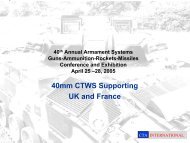Replacing Highly Enriched Uranium in Naval Reactors
Replacing_HEU_in_Naval_Reactors_Report_FINAL
Replacing_HEU_in_Naval_Reactors_Report_FINAL
You also want an ePaper? Increase the reach of your titles
YUMPU automatically turns print PDFs into web optimized ePapers that Google loves.
<strong>Replac<strong>in</strong>g</strong> <strong>Highly</strong> <strong>Enriched</strong> <strong>Uranium</strong> <strong>in</strong> <strong>Naval</strong> <strong>Reactors</strong><br />
• The issue of us<strong>in</strong>g LEU fuel for the Ohio-class replacement SSBNs should be revisited. Although tim<strong>in</strong>g may be<br />
critical, the size of the hull of the SSBN should allow for LEU life-of-the-ship cores.<br />
• A study should be undertaken to fully explore the political ramifications of cont<strong>in</strong>ued military HEU use on the<br />
prospects for a Fissile Material Cutoff Treaty and any potential feedback to the non-weapons military exemption of<br />
the Nuclear Nonproliferation Treaty from the cont<strong>in</strong>ued use of HEU.<br />
• A study should be undertaken to explore whether there could be an <strong>in</strong>ternational agreement, perhaps rem<strong>in</strong>iscent<br />
of the naval construction limitation treaties of the post-WWI period, to elim<strong>in</strong>ate the use of HEU <strong>in</strong> naval<br />
propulsion reactors. Could an agreement be reached that would be verifiable?<br />
NTI Paper 5 www.nti.org



